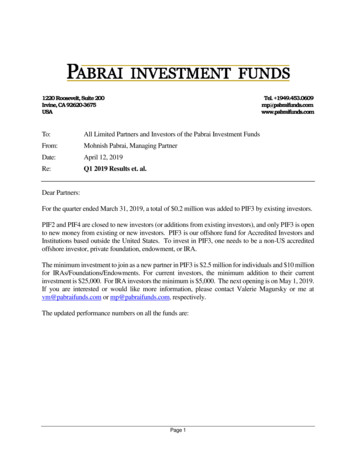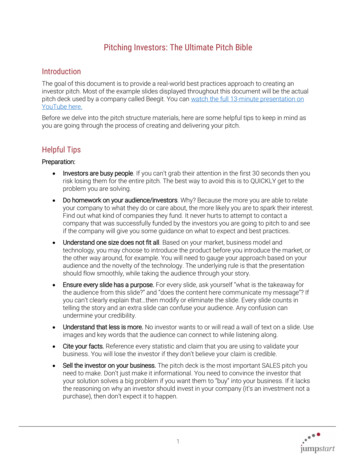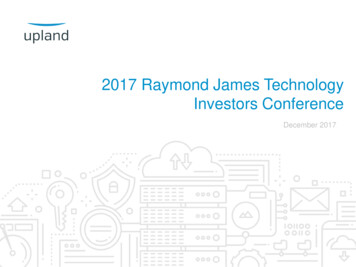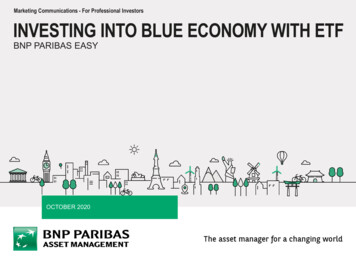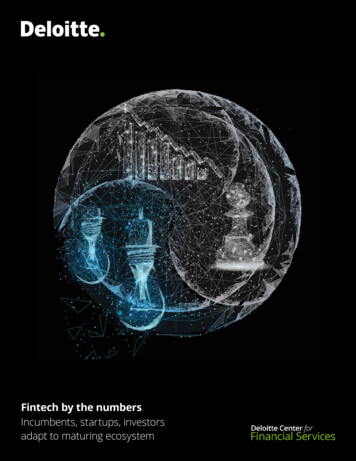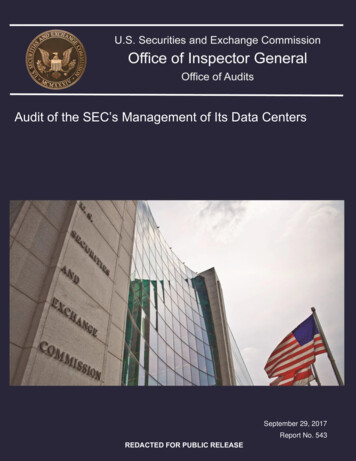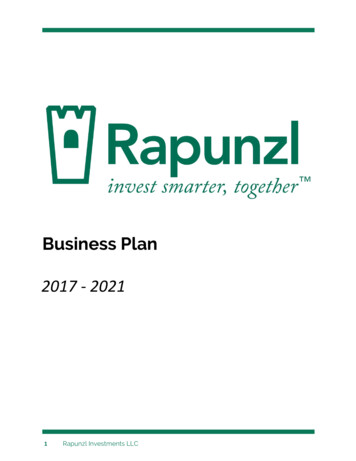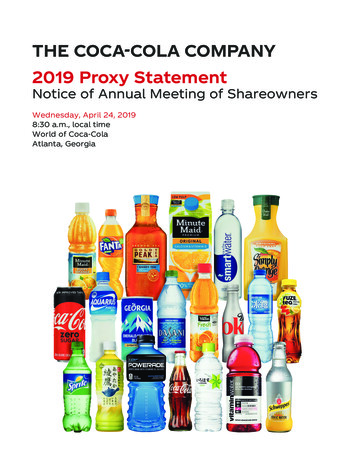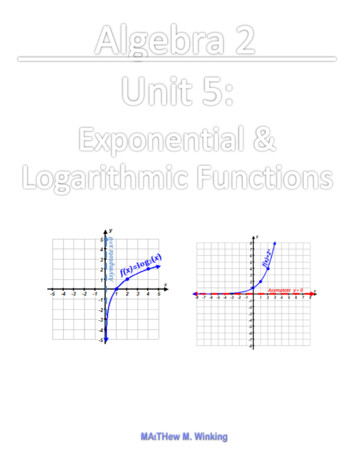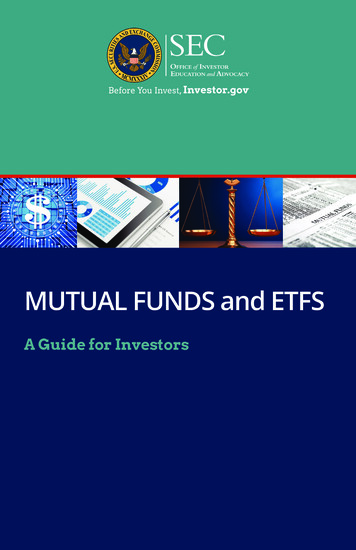
Transcription
MUTUAL FUNDS and ETFSA Guide for Investors
Mutual Funds and ExchangeTraded Funds (ETFs)American investors often turn to mutual funds and exchangetraded funds (ETFs) to save for retirement and other financialgoals. Although mutual funds and ETFs have similarities, theyhave differences that may make one option preferable for anyparticular investor. This brochure explains the basics of mutualfund and ETF investing, how each investment option works,the potential costs associated with each option, and how toresearch a particular investment.U.S. Securities and Exchange CommissionOffice of Investor Education and Advocacy100 F Street, NEWashington, DC 20549-0213Toll-free: (800) 732-0330Website: www.Investor.govU.S. SECURITIES AND EXCHANGE COMMISSION 1
Table of ContentsHow Mutual Funds and ETFs Work . . . . . . . . . . . . . . . . . .4How Mutual Funds Work . . . . . . . . . . . . . . . . . . . . . . . . . . . . . . . . . 4How ETFs Work . . . . . . . . . . . . . . . . . . . . . . . . . . . . . . . . . . . . . . . . . . 6Common Features of Mutual Funds and ETFs . . . . . . . . . . . . . . . 8Factors to Consider . . . . . . . . . . . . . . . . . . . . . . . . . . . . . . . . . . . . 11Before Investing in Mutual Funds or ETFs . . . . . . . . . . . . . . . . . . 11Different Types of Mutual Funds and ETFs . . . . . . . . . . . . . . . . . 13Different Types of Investment Strategies . . . . . . . . . . . . . . . . . . 19How Mutual Funds and ETFs Can ProvideReturns to Investors . . . . . . . . . . . . . . . . . . . . . . . . . . . . . . . . . . . . . 22Things That Could Reduce Mutual Funds’ andETFs’ Returns . . . . . . . . . . . . . . . . . . . . . . . . . . . . . . . . . . . . . . . . . . . 24Fees and Expenses . . . . . . . . . . . . . . . . . . . . . . . . . . . . . . . . . . . . . . 24Classes of Mutual Funds . . . . . . . . . . . . . . . . . . . . . . . . . . . . . . . . . 33Tax Consequences . . . . . . . . . . . . . . . . . . . . . . . . . . . . . . . . . . . . . . 36Sources of Information . . . . . . . . . . . . . . . . . . . . . . . . . . . . . . . . . . 37Avoiding Common Pitfalls . . . . . . . . . . . . . . . . . . . . . . . . . . .41Past Performance . . . . . . . . . . . . . . . . . . . . . . . . . . . . . . . . . . . . . . . 41Looking Beyond a Mutual Fund or ETF Name . . . . . . . . . . . . . . 42Bank Products Versus Mutual Funds . . . . . . . . . . . . . . . . . . . . . . 42If You Have a Question or Complaint . . . . . . . . . . . . . . . 44Glossary of Key Mutual Fundand ETF Terms . . . . . . . . . . . . . . . . . . . . . . . . . . . . . . . . . . . . . . . . 452 MUTUAL FUNDS AND ETFS
Key Points to Remember Mutual funds and ETFs are not guaranteed or insured bythe FDIC or any other government agency—even if you buythrough a bank and the fund carries the bank’s name. Youcan lose money investing in mutual funds or ETFs. Past performance is not a reliable indicator of future performance, so don’t be dazzled by last year’s high returns.But past performance can help you assess a fund’s volatilityover time. All mutual funds and ETFs have costs that lower your investment returns. Shop around and compare fees.U.S. SECURITIES AND EXCHANGE COMMISSION 3
How Mutual Funds and ETFs WorkHow Mutual Funds WorkA mutual fund is an SEC-registered open-end investmentcompany that pools money from many investors and investsthe money in stocks, bonds, short-term money-market instruments, other securities or assets, or some combination ofthese investments. The combined securities and assets themutual fund owns are known as its portfolio, which is managedby an SEC-registered investment adviser. Each mutual fundshare represents an investor’s proportionate ownership of themutual fund’s portfolio and the income the portfolio generates.Investors in mutual funds buy their shares from, and sell/redeem their shares to, the mutual funds themselves. Mutualfund shares are typically purchased from the fund directly orthrough investment professionals like brokers. Mutual fundsare required by law to price their shares each business day andthey typically do so after the major U.S. exchanges close. Thisprice—the per-share value of the mutual fund’s assets minusits liabilities—is called the NAV or net asset value. Mutual fundsmust sell and redeem their shares at the NAV that is calculatedafter the investor places a purchase or redemption order. Thismeans that, when an investor places a purchase order formutual fund shares during the day, the investor won’t knowwhat the purchase price is until the next NAV is calculated.4 MUTUAL FUNDS AND ETFS
Types of Investment CompaniesThere are three basic types of investment companies:Open-end investment companies or open-endfunds—which sell shares on a continuous basis,purchased from, and redeemed by, the fund (orthrough a broker for the fund);Closed-end investment companies or closed-endfunds—which sell a fixed number of shares at onetime (in an initial public offering) that later trade ona secondary market; andUnit Investment Trusts (UITs)—which make a onetime public offering of only a specific, fixed numberof redeemable securities called units and which willterminate and dissolve on a date that is specified atthe time the UIT is created.Mutual funds are open-end funds. ETFs are generallystructured as open-end funds, but can also be structured as UITs. ETFs operate pursuant to SEC exemptiveorders.U.S. SECURITIES AND EXCHANGE COMMISSION 5
How ETFs WorkLike mutual funds, ETFs are SEC-registered investment companies that offer investors a way to pool their money in a fundthat makes investments in stocks, bonds, other assets or somecombination of these investments and, in return, to receive aninterest in that investment pool. Unlike mutual funds, however, ETFs do not sell individual shares directly to, or redeemtheir individual shares directly from, retail investors. Instead,ETF shares are traded throughout the day on national stockexchanges and at market prices that may or may not be thesame as the NAV of the shares.ETF sponsors enter into contractual relationships with oneor more Authorized Participants—financial institutions whichare typically large broker-dealers. Typically, only AuthorizedParticipants purchase and redeem shares directly from theETF. In addition, they can do so only in large blocks (e.g., 50,000ETF shares) commonly called creation units, and they typically“pay” for the creation units in an in-kind exchange with a groupor basket of securities and other assets that generally mirrorsthe ETF’s portfolio.Once an Authorized Participant receives the block of ETFshares, the Authorized Participant may sell the ETF shares inthe secondary market to investors. An ETF share is trading ata premium when its market price is higher than the value ofits underlying holdings. An ETF share is trading at a discountwhen its market price is lower than the value of its underlyingholdings. A history of the end-of-day premiums and discountsthat an ETF experiences—i.e., its NAV per share compared toits closing market price per share—can usually be found onthe website of the ETF or its sponsor. Like a mutual fund, anETF must calculate its NAV at least once every day.6 MUTUAL FUNDS AND ETFS
A Word about Exchange-Traded Products (ETPs)ETFs are just one type of investment within a broadercategory of financial products called exchange-traded products (ETPs). ETPs constitute a diverse classof financial products that seek to provide investorswith exposure to financial instruments, financialbenchmarks, or investment strategies across a widerange of asset classes. ETP trading occurs on nationalsecurities exchanges and other secondary markets,making ETPs widely available to market participantsincluding individual investors.Other types of ETPs include exchange-tradedcommodity funds and exchange-traded notes (ETNs).Exchange-traded commodity funds are structured astrusts or partnerships that physically hold a preciousmetal or that hold a portfolio of futures or otherderivatives contracts on certain commodities or currencies. ETNs are secured debt obligations of financial institutions that trade on a securities exchange.ETN payment terms are linked to the performanceof a reference index or benchmark, representingthe ETN’s investment objective. ETNs are complex,involve many risks for interested investors, and canresult in the loss of the entire investment.This brochure discusses only ETFs that are registered as open-end investment companies or unitinvestment trusts under the Investment CompanyAct of 1940. It does not address other types of ETPs,such as exchange-traded commodity funds or ETNs.U.S. SECURITIES AND EXCHANGE COMMISSION 7
Common Features of Mutual Funds and ETFsSome common features of mutual funds and ETFs aredescribed below. Whether any particular feature is an advantage or disadvantage for you will depend on your uniquecircumstances—always be sure that the investment you areconsidering has the features that are important to you. Professional Management. Most funds and ETFs aremanaged by investment advisers who are registered withthe SEC. Diversification. Spreading investments across a wide rangeof companies or industry sectors can help lower risk if acompany or sector fails. Many investors find it less expensive to achieve such diversification through ownership ofcertain mutual funds or certain ETFs than through ownership of individual stocks or bonds. Low Minimum Investment. Some mutual funds accommodate investors who don’t have a lot of money to invest bysetting relatively low dollar amounts for the initial purchase,subsequent monthly purchases, or both. Similarly, ETFshares can often be purchased on the market for relativelylow dollar amounts.8 MUTUAL FUNDS AND ETFS
Liquidity and Trading Convenience. Mutual fundinvestors can readily redeem their shares at the nextcalculated NAV—minus any fees and charges assessed onredemption—on any business day. Mutual funds must sendinvestors payment for the shares within seven days, butmany funds provide payment sooner. ETF investors cantrade their shares on the market at any time the market isopen at the market price—minus any fees and chargesincurred at the time of sale. ETF and mutual fund sharestraded through a broker are required to settle in twobusiness days. Costs Despite Negative Returns. Investors in mutual fundsmust pay sales charges, annual fees, management fees andother expenses (discussed on pages 24–32), regardless ofhow the mutual fund performs. Investors may also have topay taxes on any capital gains distribution they receive.Investors in ETFs must pay brokerage commissions, annualfees, management fees and other expenses (discussed onpages 24–32), regardless of how the ETF performs. ETFinvestors may also have to pay taxes on any capital gainsdistributions; however, because of the structure of certainETFs that redeem proceeds in kind, taxes on ETF investmentshave historically been lower than those for mutual fundinvestments. It is important to note that the tax efficiency ofETFs is not relevant if an investor holds the mutual fund orETF investment in a tax-advantaged account, such as an IRAor a 401(k).U.S. SECURITIES AND EXCHANGE COMMISSION 9
Lack of Control. Investors in both mutual funds and ETFscannot directly influence which securities are included in thefunds’ portfolios. Potential Price Uncertainty. With an individual stock or anETF, an investor can obtain real-time (or close to real-time)pricing information with relative ease by checking financialwebsites or by calling a broker. By contrast, with a mutualfund, the price at which an investor purchases or redeemsshares will depend on the fund’s NAV, which the fund mightnot calculate until many hours after an order has beenplaced.10 MUTUAL FUNDS AND ETFS
Factors to ConsiderBefore Investing in Mutual Funds or ETFs: Determine your financial goals and risk tolerance. Whenit comes to investing in mutual funds and ETFs, investorshave thousands of choices. Before you invest in any mutualfund or ETF, you must decide whether the investment strategy and risks are a good fit for you. You should also consider more generally whether the unique style of investing ofthe mutual fund’s or ETF’s sponsor is a good fit for you. Thefirst step to successful investing is to figure out your currentfinancial goals and risk tolerance—either on your own orwith the help of an investment professional. Beware of risk. All investments carry some level of risk.An investor can lose some or all of the money he or sheinvests—the principal—because securities held by a fund goup and down in value. Dividend payments may also fluctuate as market conditions change. Mutual funds and ETFshave different risks and rewards. Generally, the higher thepotential return, the higher the risk of loss. Consider the sponsor’s investing style. Before you invest,you may want to research the sponsor of the mutual fundor ETF you are considering. The sponsor’s website is oftena good place to begin, and it is helpful to spend some timebrowsing through the website to get a better understandingof the sponsor’s underlying philosophy on investing. EachU.S. SECURITIES AND EXCHANGE COMMISSION 11
sponsor has its own style of investing that will affect how itmanages its mutual funds and ETFs. It is helpful to understand each sponsor’s style of investing, so you can betterchoose the right investment for you. Ask and check. Before you engage an investment professional or purchase shares of a mutual fund or ETF, makesure you research and verify relevant information to determine which option is best suited for you. Investment professionals: Details on an investmentprofessional’s background and qualifications are available on the SEC’s Investment Adviser Public Disclosure(IAPD) website (www.adviserinfo.sec.gov/) or on theSEC’s website for individual investors, Investor.gov.If you have any questions about checking the background of an investment professional, you can callthe SEC’s toll-free investor assistance line at (800)732-0330 for help. Mutual funds and ETFs: You can research a mutual fundor ETF by reading its prospectus (discussed on pages37-39) carefully to learn about its investment strategyand the potential risks. You can find the prospectus onthe mutual fund’s or ETF’s website or on the SEC’s EDGARdatabase (www.sec.gov/edgar/searchedgar/mutualsearch.html) and download the documents for free.12 MUTUAL FUNDS AND ETFS
A Word about DerivativesDerivatives are financial instruments whose performance is derived, at least in part, from the performance of an underlying asset, security, or index. Evensmall market movements can dramatically affect theirvalue, sometimes in unpredictable ways.There are many types of derivatives with manydifferent uses. A mutual fund’s or ETF’s prospectus willdisclose whether and how it may use derivatives. Aninvestor may also want to call a fund and ask how ituses these instruments.Different Types of Mutual Funds and ETFsMutual funds and ETFs fall into several main categories. Someare bond funds (also called fixed income funds), and some arestock funds (also called equity funds). There are also funds thatinvest in a combination of these categories, such as balancedfunds and target date funds, and newer types of funds suchas alternative funds, smart-beta funds and esoteric ETFs. Inaddition, there are money market funds, which are a specifictype of mutual fund. Bond FundsBond funds invest primarily in bonds or other types of debtsecurities. They generally have higher risks than moneymarket funds (discussed on pages 18-19), largely becauseU.S. SECURITIES AND EXCHANGE COMMISSION 13
they typically pursue strategies aimed at producing higheryields. Unlike money market funds, the SEC’s rules do notrestrict bond funds to high-quality or short-term investments.Because there are many different types of bonds, bond fundscan vary dramatically in their risks and rewards.Some of the risks associated with bond funds include: Credit Risk—the possibility that companies or otherissuers whose bonds are owned by the fund may fail topay their debts (including the debt owed to holders oftheir bonds). Credit risk is less of a factor for bond fundsthat invest in insured bonds or U.S. Treasury Bonds. Bycontrast, those that invest in the bonds of companieswith poor credit ratings generally will be subject tohigher risk; Interest Rate Risk—the risk that the market value of thebonds will go down when interest rates go up. Becauseof this, an investor can lose money in any bond fund,including those that invest only in insured bonds or U.S.Treasury Bonds. Funds that invest in longer-term bondstend to have higher interest rate risk; and, Prepayment Risk—the chance that a bond will be paidoff early. For example, if interest rates fall, a bond issuermay decide to pay off (or retire) its debt and issue newbonds that pay a lower rate. When this happens, thefund may not be able to reinvest the proceeds in aninvestment with as high a return or yield.14 MUTUAL FUNDS AND ETFS
Stock FundsStock funds invest primarily in stocks, which are also known asequities. Although a stock fund’s value can rise and fall quickly(and dramatically) over the short term, historically, stockshave performed better over the long term than other types ofinvestments—including corporate bonds, government bonds,and treasury securities.Stock funds can be subject to various investment risks,including Market Risk, which poses the greatest potentialdanger for investors in stock funds. Stock prices can fluctuatefor a broad range of reasons—such as the overall strength ofthe economy or demand for particular products or services. Balanced FundsBalanced funds invest in stocks and bonds and sometimesmoney market instruments in an attempt to reduce risk butstill provide capital appreciation and income. They are alsoknown as asset allocation funds and typically hold a relativelyfixed allocation of the categories of portfolio instruments. Butthe allocation will differ from balanced fund to balanced fund.These funds are designed to reduce risk by diversifying amonginvestment categories, but they still share the same risks thatare associated with the underlying types of instruments. Target Date FundsAlso called target date retirement funds or lifecycle funds,these funds also invest in stocks, bonds, and other investments. Target date funds are designed to be long-term investments for individuals with particular retirement dates in mind.The name of the fund often refers to its target retirement dateU.S. SECURITIES AND EXCHANGE COMMISSION 15
or target date. For example, there are funds with names suchas “Portfolio 2050,” “Retirement Fund 2050,” or “Target 2050”that are designed for individuals who intend to retire in or nearthe year 2050. Most target date funds are designed so that thefund’s allocation of investments will automatically change overtime in a way that is intended to become more conservativeas the target date approaches. That means that funds typicallyshift over time from a mix with a lot of stock investments in thebeginning to a mix weighted more toward bonds.Even if they share the same target date, target date fundsmay have very different investment strategies and risks andthe timing of their allocation changes may be different. Theyalso may have different investment results and may chargedifferent fees. Often a target date fund invests in other funds,and fees may be charged by both the target date fund and theother funds. In addition, target date funds do not guaranteethat an investor will have sufficient retirement income at thetarget date, and investors can lose money. Target date fundsare generally associated with the same risks as the underlyinginvestments. A
A mutual fund is an SEC-registered open-end investment company that pools money from many investors and invests . the money in stocks, bonds, short-term money-market instru-ments, other securities or assets, or some combination of these investments. The combined securities and assets the mutual fund
